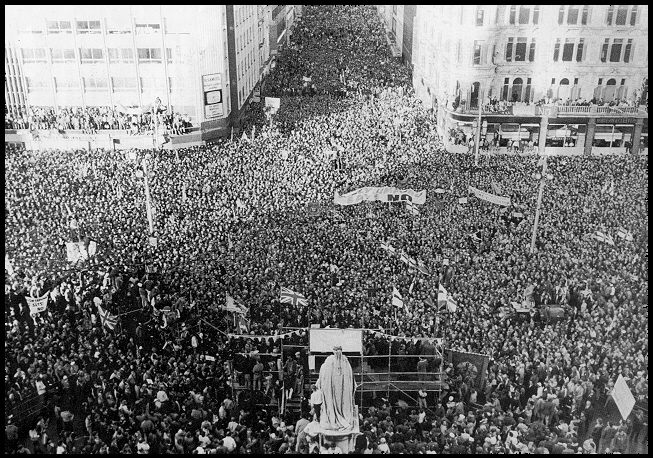
Anglo-Irish Agreement - Reaction to the Agreement[KEY_EVENTS] [Key_Issues] [Conflict_Background] AIA: [Menu] [Reading] [Summary] [Background] [Chronology] [Document] [Description] [REACTION] [Assessment] [Aftermath] [Sources] Material is added to this site on a regular basis - information on this page may change The following text has been contributed by Alan Morton, Ph.D. Student with the Irish Peace Institute Research Centre, University of Limerick. The views expressed in this page do not necessarily reflect the views of the members of the CAIN Project. The CAIN Project would welcome other material which meets our guidelines for contributions. Reaction to the AgreementReaction to the Anglo-Irish Agreement varied according to the various interpretations of its meaning. The Agreement meant different things to different people. Unionists regarded the Agreement as the beginning of the end of the Union, while republicans saw the continuation of British rule by other means. Even the framers of the document diverged in their interpretation. Britain's attempts to re-assure unionists contrasted with the Irish Government's need to defend the Agreement against republican critics.
Support for the Agreement
The reaction to the Anglo-Irish Agreement
from the international community and public opinion in the Republic
of Ireland and Britain was favourable. The traditional bi-partisan
nature of party politics in the House of Commons towards Northern
Ireland guaranteed its acquiescence. The Commons voted in favour
of the Agreement by 473 votes to 47. The Agreement was also endorsed
by a majority of members of the Oireachtas (Irish Parliament),
with Fianna Fáil (FF) voting against. Support in Northern
Ireland was limited to John Hume's Social Democratic and Labour
Party (SDLP), who had indirectly influenced its outcome through
the New Ireland Forum and who been kept informed of negotiations
through contact with the Irish Government.
Opposition to the Agreement emanated
from traditional nationalists, or republicans, in both parts of
Ireland, primarily Sinn Féin (SF) and Fianna Fáil
(FF), and most vehemently, from the unionist politicians and population
of Northern Ireland.
Opposition from Republicans
As leader of the Fianna Fáil
'The Republican Party' (FF), Charles Haughey had previously highlighted
the unitary state option of the New Ireland Forum recommendations
as the only workable solution. Haughey claimed in the Oireachtas
(Irish Parliament) that the Anglo-Irish Agreement was incompatible
with articles 2 and 3 of the Irish Constitution (Bunreacht na
hEireann), which claims that 'the national territory consists
of the whole island of Ireland'. Haughey contended that 'by confirming
what is called the constitutional status of Northern Ireland as
an integral part of the United Kingdom, this Agreement will do
serious damage in the eyes of the world to Ireland's historic
and legitimate claim to the unity of her territory' (quoted in
Hadden & Boyle, 1989). Haughey later committed himself to
working with the Agreement prior to acceding to power in 1987.
Similarly, republicans in Northern Ireland
rejected the Agreement as falling short of their political demand
for a united Ireland and immediate British withdrawal from Northern
Ireland. Sinn Féin (SF) leader Gerry Adams regarded the
Agreement as a sell-out to Britain in that it copper-fastened
partition and British rule.
Opposition from Unionists
Both Governments under-estimated the
strength of the opposition from the unionist community of Northern
Ireland. Mass
protest rallies
were organised to protest against
the Agreement under the campaign heading 'Ulster Says No'. Over
100,000 people gathered in Belfast on 23 November 1985 to hear
speeches of protest from James Molyneuax, leader of the Ulster
Unionist Party (UUP) and Ian Paisley, leader of the Democratic
Unionist Party (DUP).
Unionist opposition stemmed from three
main factors. Firstly, unionist political leaders were excluded
from the formal negotiations that led to the Agreement. This
factor led to future President Mary Robinson's resignation from
the Labour Party in the Republic. Secondly, the Irish Government
was given a consultative role in the affairs of Northern Ireland
for the first time. Northern Ireland's place in the United Kingdom
was perceived as threatened. The unionist-controlled Grand Committee
of the Northern Ireland Assembly argued, with some justification,
that 'Northern Ireland is no longer a part of the United Kingdom
on the same basis as Great Britain' (Grand Committee
of the Northern Ireland Assembly First Report, quoted in Hadden
and Boyle, 1989). Many unionists saw the Agreement as a 'joint
authority in embryo' (ibid.). Finally, unionists were
excluded from the levers of power until they accepted a devolved
power-sharing regime.
Opposition to the Agreement from mainstream
unionist politicians gradually became more muted as more extreme
elements became involved in unconstitutional attempts to undermine
it. But unionist opposition to the involvement of the Dublin
Government in the affairs of Northern Ireland through the Anglo-Irish
Agreement structures has remained to this day.
Reaction from Paramilitaries In his autobiography, Garret FitzGerald (1991) contends that paramilitary reaction to the Agreement was much less severe than either government expected. That the Governments expected increased paramilitary activity demonstrates that the aim of peace and reconciliation was a longer term objective of the Agreement.
Loyalist paramilitary groups increased
their attacks on Catholics and also targeted RUC officers. This
particular phase of their campaign peaked between March and May
of 1986. The Irish Republican Army (IRA) widened its definition
of 'legitimate targets' to include people involved in commercial
relations with the security forces. The IRA campaign was boosted
in 1987 by a large shipment of military hardware from Libya.
Both extremes were keen to show the Agreement was not working.
However, the increase in levels of violence cannot be attributed
to the Agreement alone. Other factors must be considered, such
as the shipment of arms from Libya.
|
CAIN
contains information and source material on the conflict
and politics in Northern Ireland. CAIN is based within Ulster University. |
|
|
|||
|
Last modified :
|
||
|
| ||
